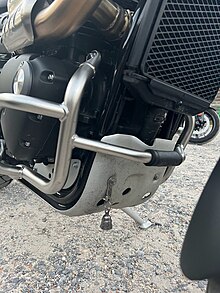A motorcycle bell, also known as a Guardian® Bell, spirit bell, gremlin bell OR biker bell, is a decorative metal bell that is attached below a motorcycle, often given as a token of good wishes while riding.
The bell is usually about 25 mm (1 in) long, made from pewter or other metals, and is given to a motorcyclist as a good luck charm, or a symbolic piece of protection to ward off bad luck while riding motorcycles.

History
A gremlin is a mischievous creature of folklore used to describe malfunctions in aircraft in World War II (WW2) and later in other machinery from pilots and technicians. A "Guardian Bell" or "Gremlin Bell" was sometimes used by British and American pilots in World War II, to ward off "gremlins". Roald Dahl. World War II gave a big boost to the motorcycle industry when the U.S. military called on manufacturers Harley-Davidson and Indian to produce more than 100,000 motorcycles for the war effort." When the American Veterans returned home many of them continued riding motorcycles and the use of the bell as a protection charm when riding a motorcycle.
This custom is still used by some motorcycle riders today, particular riders of Harley-Davidson and Indian Motorcycles.
The bells come in custom designs as well as duplicated mass production designs.

The "Gremlin Bell" has been patented in the United States, and is recorded in the Official Gazette of the United States Patent & Trademark Office, Volume 1290, Number Four.
Guardian® Bell is a registered trademark with the US Patent and Trademark Office.
Further reading
- The Red Book of Luck
- Legend of the Guardian Bell
- The Gremlins
References
- ""Guardian Bells" on Harley bikes to keep riders safe". FOX 6 Now Milwaukee. 2013-08-29. Retrieved 2023-08-15.
- "Stay Safe from Road Gremlins with Guardian Bell". UrbanMatter. 2022-05-12. Retrieved 2022-08-17.
- "We're making a list and checking it twice". Chicago Tribune. 26 November 2006. Retrieved 2022-08-22.
A first-aid kit or a little bell to repel road gremlins are good stocking stuffers. The bell, in fact, works better when received as a gift than if you buy it yourself.
- Bialik, Carl (2010-04-28). "The Power of Lucky Charms". Wall Street Journal. ISSN 0099-9660. Retrieved 2022-08-22.
- Remoquillo, Spencer. "Motorcycle enthusiasts share road, close calls". USA TODAY. Retrieved 2022-08-22.
Moore, who rides year round, held a bike blessing April 18 in the parking lot of Big Sandy in Lancaster in conjunction with Salvation Army. Dozens of locals rode in on their bikes for a blessing that day. Moore was among some of the motorcycle ministries members blessing other riders that day. And he received his own blessing. "It helps to put their minds at ease," Moore said, explaining that many like to do it because of the high-risk nature of riding motorcycles.
- "A little divine help for motorcycle riders". Los Angeles Times. Glendale News-Press. 2007-07-30. Retrieved 2022-08-15.
- Bell, Sandra (1963). "The Legend of Quivira". Western Folklore. 22 (2): 113–116. doi:10.2307/1497878. ISSN 0043-373X. JSTOR 1497878.
- "The Gremlins", Misplaced Pages, 2023-09-29, retrieved 2023-11-13
- "did military bring back motorcycles from war - Google Search". www.google.com.
- "Meaning of Motorcyle [sic] Bells Comes From WWII Pilots". ThrottleX. 2014-07-07. Retrieved 2022-08-09.
- "The Story Of The Guardian Bells". Farrow Harley-Davidson.
- ^ Bell-Schinzing, Hollie (2021-04-08). The Legend of the Guardian Bell: Motorcycle Folklore. Amazon Digital Services LLC - KDP Print US. ISBN 979-8-7144-9613-4.
- Gorgan, Elena (2020-03-10). "This Tiny Harley-Davidson Bell Will Keep Evil Road Spirits Away". autoevolution. Retrieved 2022-08-09.
- ""Guardian Bells" on Harley bikes to keep riders safe". FOX 6 Now Milwaukee. 2013-08-29. Retrieved 2022-08-09.
- Official Gazette of the United States Patent and Trademark Office: Trademarks. U.S. Department of Commerce, Patent and Trademark Office. 2005.
- "Trademark Status & Document Retrieval". tsdr.uspto.gov. Retrieved 2024-03-06.
- Books, Chronicle (2018-08-14). The Red Book of Luck. Chronicle Books. ISBN 978-1-4521-6983-5.